




OUR BEST EVER OFFER - SAVE £100/$100
JOIN THE WORLD'S LEADING PROFESSIONAL DEVELOPMENT PROGRAMME
- 12 months membership of Elite Soccer
- Print copy of Elite Player & Coach Development
- Print copy of The Training Ground
You are viewing 1 of your 1 free articles
Collective defending principles
This session is all about collective defending principles, focusing on team organisation when pressing from the front and defensive organisation when the press is beaten by the opposition.
| Area | Up to full pitch |
| Equipment | Balls, bibs, cones, 4 mini target goals, 2 full size goals |
| No. of Players | Up to 20 players + 2 goalkeepers |
| Session Time | Defending possession: 20mins Pressing game: 20mins 11v11 game: 10mins |
This session is all about collective defending principles, focusing on team organisation when pressing from the front and defensive organisation when the press is beaten by the opposition.
It deals with two phases. The first phase is the initial set-up of the team when play starts from an opposition goalkeeper, and it rehearses our team to direct the opposition into an area where we can win the ball.
The second phase is understanding our team’s organization and principles once the opposition has been able the play through our press or has been able to change the point of attack.
I believe this session allows the players to understand the dilemma of “what if” we cannot win the ball in the first phase. This session allows the players to understand that we may not win the ball in the first instance when we press, so it’s important to understand our collective principles if the opposition are clever enough to play through or around our defensive set-up.
It is important to note that part of this session is also about our position when we have won the ball: can we position ourselves to play vertically, or do we need to retain control of the ball to prepare our attacking structure?
This session was designed as tactical information for our general pressing for when an opposition team builds up with a back four and one or two holding midfielders. A session of this type is usually inserted in the middle of the week in preparation for a game. It usually has an extensive physical output – longer distances and bigger spaces.
“This session allows the players to understand that we may not win the ball in the first instance when we press”
DEFENDING POSSESSION
Players start by warming up in preparation for the session. The warm-up [not shown] will include some principles of defending – body shape, pressing defenders and directing them one way. This will be non-contact and will include the ball-players. Then the players are prepared for the unit information work.
The first activity works on defending principles in small groups. We set up a playing area of 26x18 yards with two mini target goals at each end. We’re using nine outfield players split into a blue attacking team of six and a red defending team of three. Three blues start in each of the end zones, with the red team starting in the middle zone.
The blues look to move the ball between the two end zones, either by playing between the lines or by exploiting space in behind. The reds look to force the blues wide or force them into a mistake. One red defender can go into the end zone in order to press, while the other two defenders remain in the middle zone, where they look to block passing lanes, as shown [1].
[1]
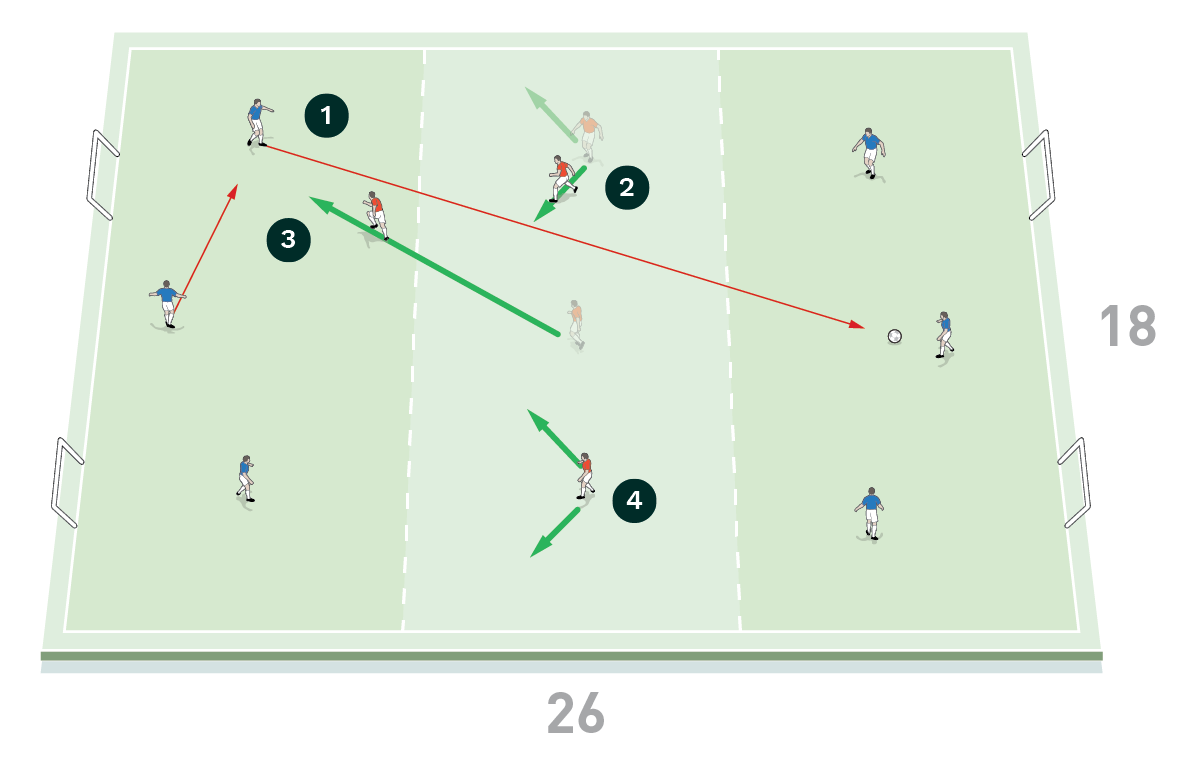
- The blues look to move the ball between the two end zones, either by playing between the lines or by exploiting space in behind
- The red team look to force the blues wide, or force them into a mistake
- One red defender can go into the end zone to press the ball
- The two remaining defenders look to block passing lanes
- If the red defenders win possession, they look to attack the mini goals, while on losing possession the blues must transition to defend the mini goals
If the red defenders win possession, they look to attack the mini goals and on losing possession the blues must transition to defend the mini goals.
PRESSING GAME
The Pressing Game is the main coaching component of the session. We set up on a half a pitch with a full size goal and a goalkeeper at each end. The playing area is split into thirds – an end zone is made up of two thirds of the playing area, while a midfield zone is made up of one third of the playing area.
We’re using 15 outfield players split into a red defending team of seven and a blue attacking team eight. The blue team have a 6v5 advantage in the large end zone, whereas it’s 2v2 in the midfield zone.
The red goalkeeper starts with the ball, playing it to a defender. The reds try to build an attack from the back while the two blue strikers press high and look to force the build-up play into a wide area, as shown [2a].
[2a]
- The blue team have a 6v5 advantage in the large end zone
- It’s 2v2 in the midfield zone
- The red keeper starts play, passing the ball to a defender. The reds try to build an attack from the back
- The two blue strikers press high and look to force the build-up play into a wide area
As the reds look to work the ball up the pitch, the second block of blue players press the opposition full back and try to cut out central passes. The blue holding midfielder screens the three players in front to either press or balance and cover, as shown [2b].
[2b]
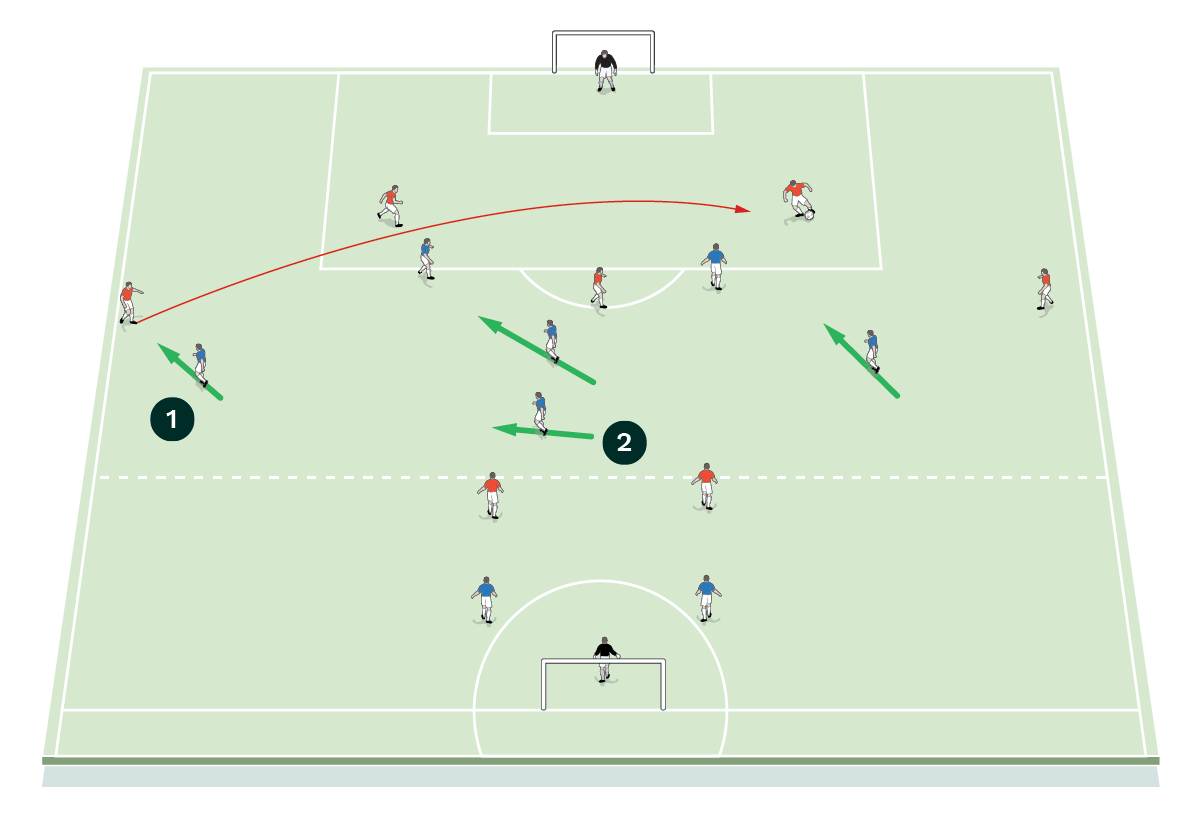
- As the reds look to work the ball up the pitch, the second block of blue players press the opposition full back and look to cut out any central passes
- The blue holding midfielder screens the three players in front to either press or balance and cover accordingly
“The reds are encouraged to work the ball into wide positions and cross it in, so the blue defenders have to deal with crosses
If the red team works the ball into the middle third, all players are now involved in the game and the reds are encouraged to work the ball wide and cross it in, so the blue defenders have to deal with crosses, as shown [2c].
[2c]
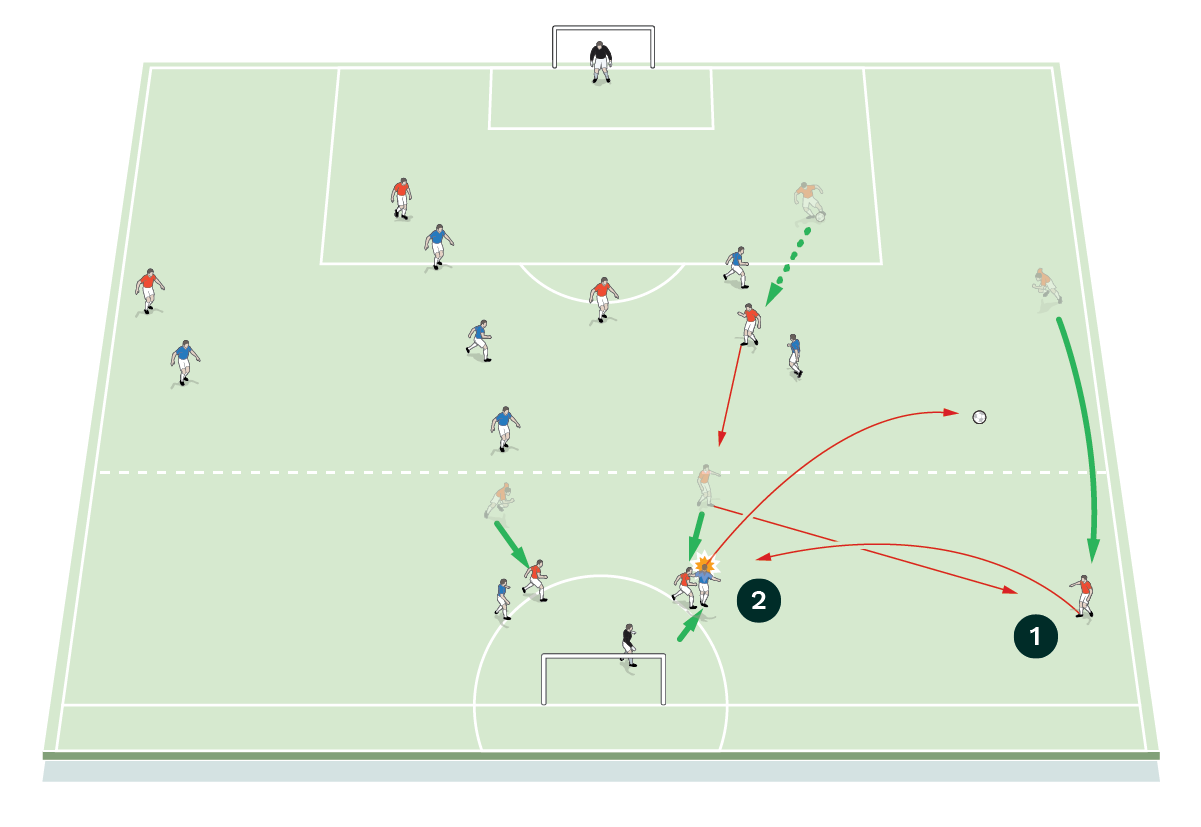
- If the reds work the ball into the midfield third, they should try to play the ball wide and cross
- The blue defenders should deal with the crosses and clear the ball
If the blue team win the ball back, they can counter-attack and look to score a goal, as shown [2d].
[2d]
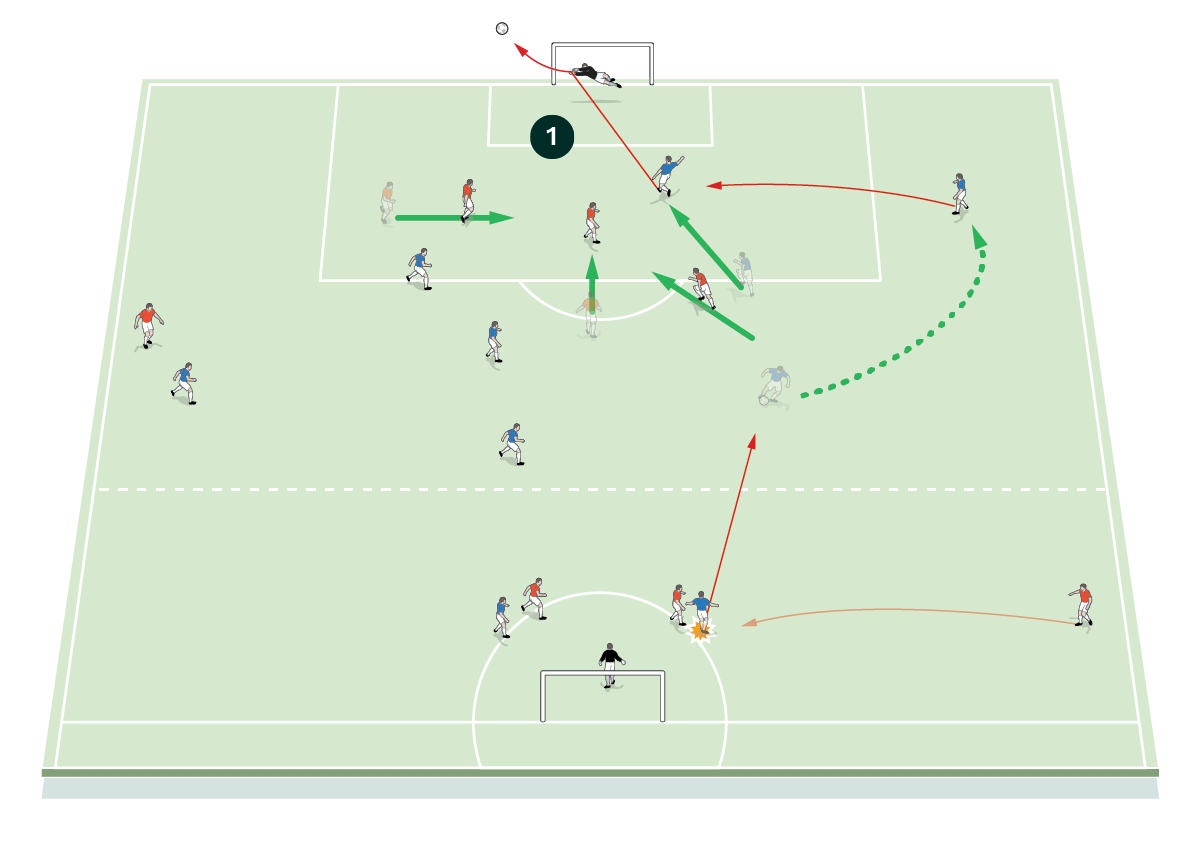
- If the blue team wins the ball back, they can counter-attack and look to score a goal
11v11 GAME
We set up a playing area between the two penalty, boxes coned off to a width of 60 yards and with a full size goal and a goalkeeper at each end. An end zone is marked out at each end, with a midfield zone in the centre. We’re using 20 outfield players split into two teams of 11 including keepers.
Play starts with a ball played from the blue team’s goalkeeper to one of the blue defenders. The red team cannot enter the blue defensive end zone to press.
The blues must try to work the ball up the pitch but once the blues have passed it into their attacking end zone, the red team can now drop to defend. If the possession team score a goal, they get a point, as shown [3a].
[3a]

- Play starts with a ball played from the blue team’s goalkeeper to one of the blue defenders
- The red team cannot enter the blue defensive end zone to press
- The blues must try to work the ball up the pitch but once they have played it into their attacking end zone, the red team can now drop to defend
- If the possession team score a goal, they get a point
If the out-of-possession team wins the ball high up in the midfield zone and score a goal, this is worth two points, as shown [3b].
[3b]
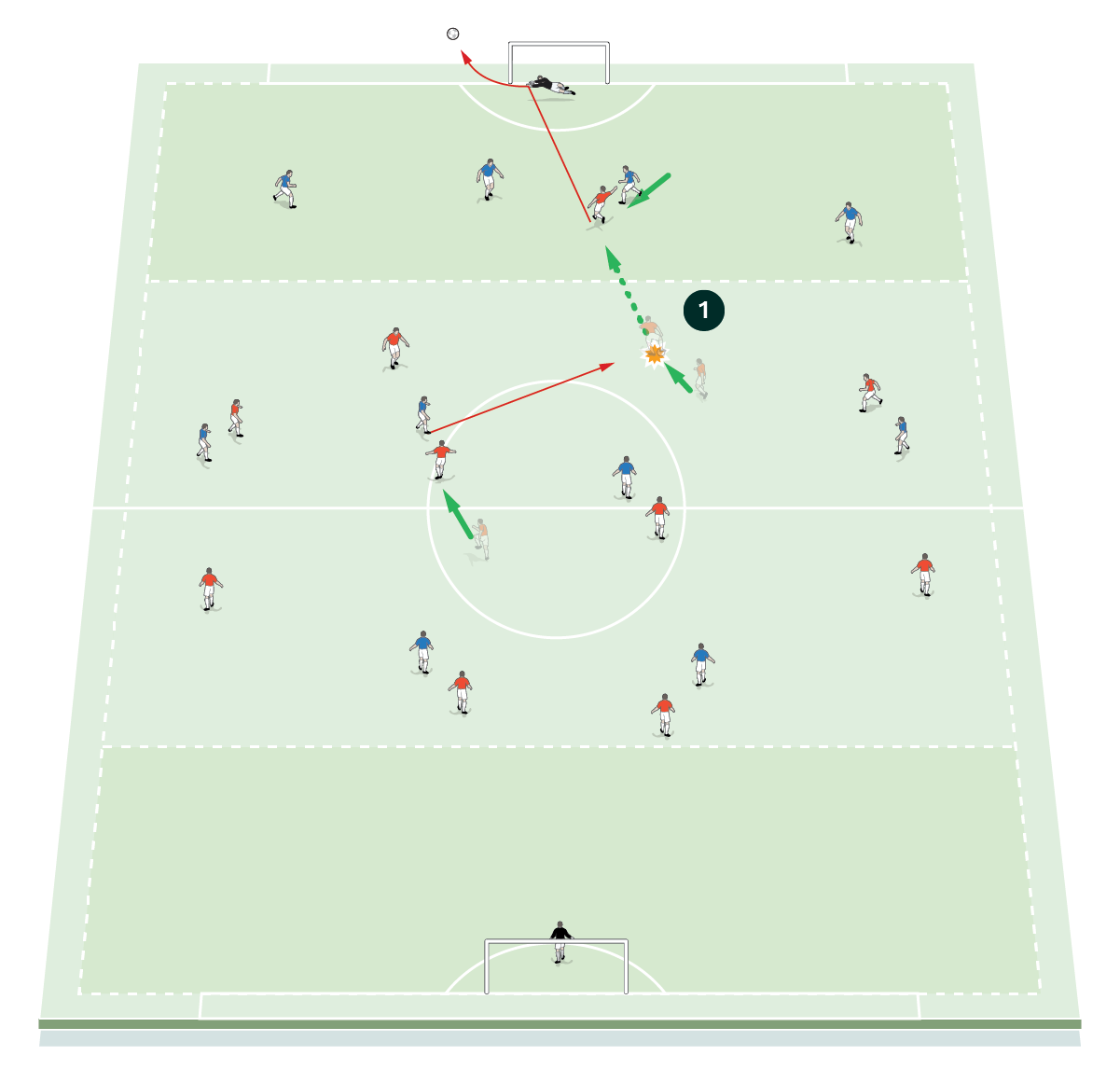
- If the out-of-possession team (here the red team) wins the ball high up in the midfield zone and score a goal, it is worth two points
COACHING POINTS
What are the key things to look for?
The session is designed from technical principles of individual 1v1 defending to working as a unit to working collectively as a team. Each component of the session progresses to achieve game simulated situations with cues and triggers that are commonplace so that the team understands what to do in certain situations. For instance, if the opposition team has changed the point of attack, we are now in a mid-block defensive phase preparing to force the opposition to one side.
Things we want to see include the players working together collectively, with little distance in between the player who is pressing the ball and the second and third defenders to direct the opposition into wide areas for us to possibly win the ball. Keeping the distances close for when we do win the ball, we have options and outlets – if the opposition are clever enough to play in between us or around us, our goal is to collectively come underneath the ball, regroup and protect central areas.
We also want to keep the ball where we can see it and after any backward pass or negative pass, we must reduce the spaces by lifting the team until the opposition is facing forward.
What are the typical mistakes players might make and how do I avoid them?
The typical mistakes players make involve the timings of when to press and when to wait. This is due to the set-up and an indicator of the second line of press not being prepared. If they do press aggressively, there are times they press just for the sake of putting pressure on the ball and not directing it into traffic or trouble.
Related Files
Editor's Picks
Attacking transitions
Deep runs in the final third
Using the goalkeeper in build-up play
Intensive boxes drill with goals
Penetrating the final third
Creating and finishing
My philosophy
Pressing initiation
Compact team movement
Coaches' Testimonials

Alan Pardew

Arsène Wenger

Brendan Rodgers

Carlos Carvalhal

José Mourinho

Jürgen Klopp

Pep Guardiola

Roy Hodgson

Sir Alex Ferguson

Steven Gerrard
Coaches' Testimonials

Gerald Kearney, Downtown Las Vegas Soccer Club

Paul Butler, Florida, USA

Rick Shields, Springboro, USA

Tony Green, Pierrefonds Titans, Quebec, Canada
Join the world's leading coaches and managers and discover for yourself one of the best kept secrets in coaching. No other training tool on the planet is written or read by the calibre of names you’ll find in Elite Soccer.
In a recent survey 92% of subscribers said Elite Soccer makes them more confident, 89% said it makes them a more effective coach and 91% said it makes them more inspired.
Get Monthly Inspiration
All the latest techniques and approaches
Since 2010 Elite Soccer has given subscribers exclusive insight into the training ground practices of the world’s best coaches. Published in partnership with the League Managers Association we have unparalleled access to the leading lights in the English leagues, as well as a host of international managers.
Elite Soccer exclusively features sessions written by the coaches themselves. There are no observed sessions and no sessions “in the style of”, just first-hand advice delivered direct to you from the coach.






